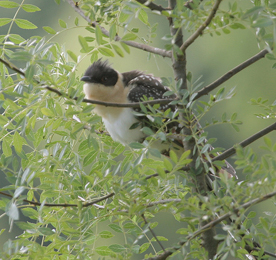| |



  
|
Brood parasitism and cooperative hosts
 |
Brood parasites are birds that lay their eggs in the nests of other species (the "hosts"), and have their offspring raised by the host parents. In some parasitic species (such as the Common cuckoo Cuculus canorus) the newly hatched chick expels all other eggs and chicks from the nest and so avoids competition for food. Chicks of other parasitic species (like the Great-spotted cuckoo Clamator glandarius) don't do so and are raised alongside the host chicks. |
In evolutionary time spans, some
hosts have evolved defences against
the brood parasites, as for example
the ability of recognizing and ejecting foreign eggs, and aggressive behaviour towards parasitic adults in the proximity of the nest in order to reduce laying opportunities. In response to these defences, brood parasites have
counter-evolved strategies to "fool"
the host into accepting alien egg, as
for example improvement of resemblance between parasitic and host eggs, or reduction of laying time. When parasitic chicks hatch, they also show amazing adaptations to stimulate host parents
in feeding them at high frequencies, sometimes much higher that the hosts would have done with their own brood.
Such co-evolutionary interactions between parasites and hosts have been studied for long time in biparental host species, where only the breeding pair cares for the offspring. However, much less is known about cooperatively breeding hosts, where more than two individuals provision the nestlings. How does group size affect parasitism rate? Do parasites prefer nests of unassisted pairs or cooperative groups to lay their eggs in? Do larger groups defend better the nest against brood parasites? Do parasitic chicks grow better in nests with helpers? We answered these questions by investigating the interactions between cooperative carrion crows and their brood parasite, the Great-spotted cuckoo.
By analysing data on parasitism rate in groups of different sizes monitored over several years, we discovered that unassisted pairs, despite their relative rarity compared to larger social units, were more heavily parasitized than cooperative groups. Furthermore, adult cuckoos that chose nests held by pairs could better synchronize their laying date with that of the host, providing an age advantage to the parasitic chicks over host chicks that improved their competitive abilities when begging for food and, consequently, their survival. We propose that larger groups were better protected against parasitism due to a passive effect of the presence of helpers, rather than to an active defence against adult cuckoos. During laying and incubation, breeding females that are assisted by a larger number of helpers are fed at the nest and do not need to leave for foraging, unlike unassisted females that leave the nest unattended for longer periods and, therefore, augment the opportunities for adult cuckoos to lay their own eggs.
Geographic variation of host use by the great spotted cuckoo. Avian brood parasites choose host species with characteristics that better suit diet requirements, incubation and nestling period of parasitic chicks, in order to maximize survival probabilities of their offspring. However, most host species have evolved defences against brood parasite (such as recognition and ejection of alien eggs and active nest defence) in order to avoid the high reproductive costs of parasitism. Brood parasites, as a response, have evolved counter-adaptations such as mimetic eggs that resemble those of the host species, and shorter laying time to avoid aggressions. Sometimes, a host species “wins” the evolutionary arms race and develops defensive strategies so efficient, that the brood parasite is forced to switch to a new host. Therefore, changes in host use are usually attributed to variation in reproductive success due to host characteristics (e.g. abundance, laying period) and/or the evolution of host strong defences.
We are currently investigating the factors determining geographic variations in host use by the great spotted cuckoo in Spain. This brood parasite preferentially lays eggs in nests of magpies Pica pica throughout Europe, while carrion crows are used as secondary host. However, since 2004 we have observed a dramatic increase in parasitism rate on carrion crows in Northern Spain, with about 70% of parasitized nests in 2010. Since 2007 we have been collecting data on parasitism in magpies and carrion crows in Northern and Southern Spain (where magpies have been always used as primary host), to investigate whether changes in host abundance, laying periods, defensive strategies, and nest accessibility can explain the rapid increase in the use of carrion crows in Northern Spain and if we are currently observing a local change of host by the great spotted cuckoo.
| |





